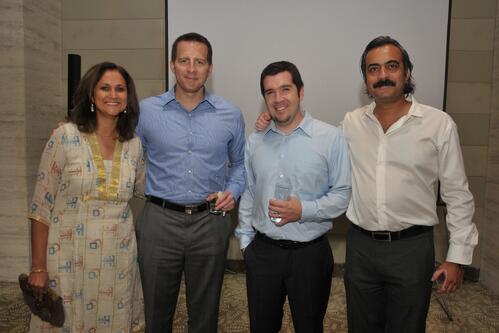 Last month, Hogan celebrated its annual Hogan Game Day competition, a team-based version of the popular game show “Minute to Win It” that is a much-anticipated event at our Tulsa office.
Last month, Hogan celebrated its annual Hogan Game Day competition, a team-based version of the popular game show “Minute to Win It” that is a much-anticipated event at our Tulsa office.
In the week leading up to Game Day, and the week that followed, the halls were alive with spirited banter (and sometimes outright trash-talk). Our elite marketing team, which planned the event, kept the list of games close to its vest, and for good reason. There are those competitively spirited individuals at Hogan who would have mastered each challenge before Game Day actually took place! Needless to say, Game Day is a big deal around here. And even though my team took last place, my experience far outweighed earning a trophy.
To kick off the event, each employee was randomly assigned teams and tasked with generating a team name (we were Hogan’s Heathens) and deciding who would participate in each event:
Game 1: Stick To It – Two team members, a thrower and catcher, bounce ping pong balls across a table and catch them with a pair of lint rollers. Three balls per roller, one minute to win it.
Game 2: Hanky Panky – One team member pulls out an entire box of tissues, one at a time, in one minute.
Game 3: Breakfast Scramble – One team member solves a puzzle consisting of the front of a box of cereal cut into perfect squares in less than one minute.
Game 4: Dizzy Mummy – Two team members, a holder and turner, wrap a roll of toilet paper around the turner in under one minute.
Game 5: Triple Pong Plop – One team member bounces ping pong balls on a plate and into a fish bowl.
Game 6: Face the Cookie – One team member places an Oreo on their forehead and, without using his/her hands, moves the cookie into his/her mouth.
RELAY: Five team members push a lemon across a 10-yard section of the parking lot with chopsticks. The first team with all members down and back won.
Some would suggest such team-building activities are wasteful, but consider the employee whose only workplace social incentive or team-building event is a break room birthday party or casual Friday. Now consider workers at Apple, Google, Facebook, or other unconventional workplace where a shift in corporate culture – the addition of office game rooms, flex time, office pets, happy hours, or casual dress codes - makes their work lives more enjoyable.
And these initiatives aren’t just to attract quality employees – though applicants are beating the door down to work there – they are examples of low-cost agendas that seriously drive engagement and pride through higher employee satisfaction.
It wouldn’t be appropriate for every business to install a basketball court in its offices, but that doesn’t mean it can’t do something for its people. Creating creature comforts at work not only increases satisfaction, but it also motivates employees to work harder. It’s common to see workers at many of these workplaces voluntarily burning the midnight oil. What motivates your staff?
 I can think of few more noble/worthy causes than breaking the cycle of poverty through improving childhood educational outcomes. Here in Oklahoma, much of that work is being done through an organization called Tulsa Educare, a research-based program that brings the best early childhood practices to underserved and at-risk populations. Tulsa Educare is the first program of its kind to be implemented on such a large scale, and as such has been making news – the New York Times recently featured Tulsa Educare and suggested it as a model for a nation-wide program.
I can think of few more noble/worthy causes than breaking the cycle of poverty through improving childhood educational outcomes. Here in Oklahoma, much of that work is being done through an organization called Tulsa Educare, a research-based program that brings the best early childhood practices to underserved and at-risk populations. Tulsa Educare is the first program of its kind to be implemented on such a large scale, and as such has been making news – the New York Times recently featured Tulsa Educare and suggested it as a model for a nation-wide program.


 Last month, Hogan celebrated its annual Hogan Game Day competition, a team-based version of the popular game show “Minute to Win It” that is a much-anticipated event at our Tulsa office.
Last month, Hogan celebrated its annual Hogan Game Day competition, a team-based version of the popular game show “Minute to Win It” that is a much-anticipated event at our Tulsa office.